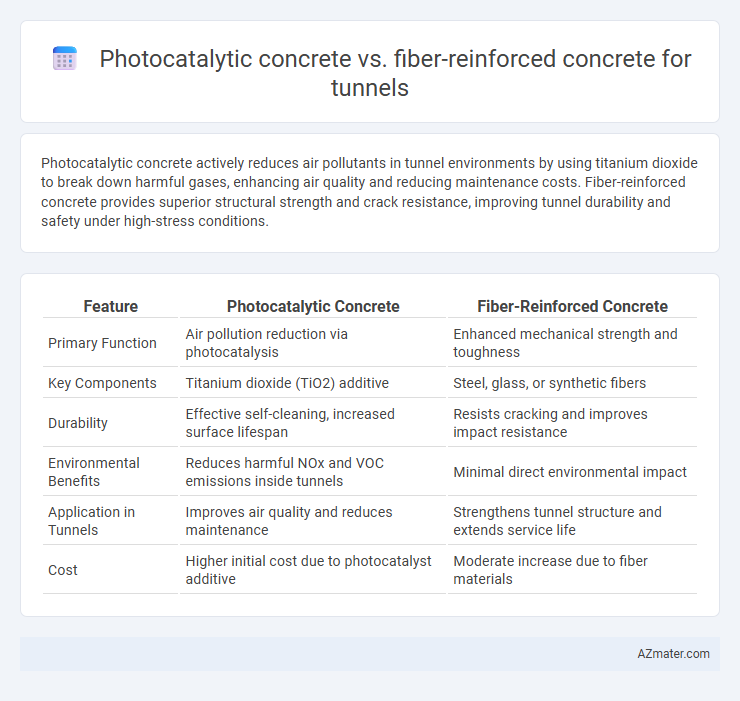Photocatalytic concrete actively reduces air pollutants in tunnel environments by using titanium dioxide to break down harmful gases, enhancing air quality and reducing maintenance costs. Fiber-reinforced concrete provides superior structural strength and crack resistance, improving tunnel durability and safety under high-stress conditions.
Table of Comparison
| Feature | Photocatalytic Concrete | Fiber-Reinforced Concrete |
|---|---|---|
| Primary Function | Air pollution reduction via photocatalysis | Enhanced mechanical strength and toughness |
| Key Components | Titanium dioxide (TiO2) additive | Steel, glass, or synthetic fibers |
| Durability | Effective self-cleaning, increased surface lifespan | Resists cracking and improves impact resistance |
| Environmental Benefits | Reduces harmful NOx and VOC emissions inside tunnels | Minimal direct environmental impact |
| Application in Tunnels | Improves air quality and reduces maintenance | Strengthens tunnel structure and extends service life |
| Cost | Higher initial cost due to photocatalyst additive | Moderate increase due to fiber materials |
Introduction to Advanced Tunnel Concrete Technologies
Photocatalytic concrete integrates titanium dioxide to reduce air pollution by breaking down pollutants on tunnel surfaces, enhancing environmental quality inside tunnels. Fiber-reinforced concrete incorporates synthetic or steel fibers to improve tensile strength, crack resistance, and durability under heavy traffic and dynamic loads in tunnel structures. Advanced tunnel concrete technologies prioritize these innovations to achieve longer service life, reduced maintenance, and improved safety in demanding underground environments.
Understanding Photocatalytic Concrete: Mechanisms and Benefits
Photocatalytic concrete incorporates titanium dioxide (TiO2) particles that activate under ultraviolet light to break down pollutants, significantly improving tunnel air quality by reducing nitrogen oxides and volatile organic compounds. This self-cleaning mechanism not only enhances tunnel visibility and aesthetics but also lowers maintenance costs by preventing grime buildup. Compared to fiber-reinforced concrete, which primarily improves structural integrity and crack resistance, photocatalytic concrete offers environmental benefits by actively degrading harmful airborne contaminants.
Fiber-Reinforced Concrete: Composition and Structural Advantages
Fiber-reinforced concrete for tunnels typically incorporates steel, glass, synthetic, or natural fibers uniformly distributed within the cement matrix, enhancing tensile strength and crack resistance. This composition improves durability, impact resistance, and deformation capacity under dynamic loads common in tunnel structures. The structural advantages of fiber-reinforced concrete include improved load-bearing capacity, reduced shrinkage cracks, and enhanced long-term performance, making it ideal for complex tunnel engineering projects.
Comparative Durability in Tunnel Environments
Photocatalytic concrete offers superior self-cleaning and pollution-reducing properties, enhancing surface durability by decomposing harmful organic compounds and preventing surface degradation in tunnel environments. Fiber-reinforced concrete improves structural durability by increasing tensile strength and crack resistance, which is critical under cyclic loading and vibration typical in tunnels. While photocatalytic concrete excels in surface maintenance and air quality improvement, fiber-reinforced concrete provides enhanced resistance to mechanical stresses and long-term structural integrity within tunnels.
Air Purification and Self-Cleaning Properties
Photocatalytic concrete integrates titanium dioxide (TiO2) nanoparticles that catalyze the breakdown of pollutants like nitrogen oxides (NOx) and volatile organic compounds (VOCs) under UV light, significantly enhancing air purification within tunnel environments. Fiber-reinforced concrete primarily improves structural durability and crack resistance but lacks intrinsic air purification capabilities, making it less effective for reducing pollutant accumulation. The self-cleaning properties of photocatalytic concrete prevent surface grime and microbial growth by accelerating the degradation of organic matter, thereby maintaining tunnel aesthetics and reducing maintenance frequency compared to fiber-reinforced concrete.
Mechanical Strength and Crack Resistance
Photocatalytic concrete enhances tunnel durability by integrating titanium dioxide, which improves surface self-cleaning and maintains mechanical strength under environmental exposure. Fiber-reinforced concrete incorporates synthetic or steel fibers that significantly increase tensile strength and crack resistance, reducing microcrack propagation in tunnel structures. Comparative studies reveal fiber-reinforced concrete generally offers superior crack control and mechanical performance, while photocatalytic concrete provides additional environmental benefits without compromising structural integrity.
Installation and Maintenance Considerations
Photocatalytic concrete, containing titanium dioxide, offers self-cleaning and pollution-reducing properties ideal for tunnel environments but requires careful UV exposure during installation to activate its photocatalytic effects. Fiber-reinforced concrete enhances structural strength and crack resistance, simplifying installation by reducing curing time and minimizing cracking, which lowers maintenance frequency. Maintenance of photocatalytic concrete demands monitoring surface integrity to maintain photocatalytic efficiency, while fiber-reinforced concrete primarily requires inspection for fiber degradation or matrix deterioration over prolonged tunnel use.
Environmental Impact and Sustainability
Photocatalytic concrete incorporates titanium dioxide to actively reduce air pollutants like nitrogen oxides, enhancing tunnel air quality and contributing to urban sustainability efforts. Fiber-reinforced concrete improves structural durability and longevity by resisting cracking and abrasion, which reduces maintenance frequency and resource consumption over the tunnel's lifecycle. Both materials advance environmental goals, with photocatalytic concrete focusing on air purification and fiber-reinforced concrete emphasizing reduced material waste and extended infrastructure lifespan.
Cost Analysis: Photocatalytic vs Fiber-Reinforced Concrete
Photocatalytic concrete typically presents higher initial costs due to advanced titanium dioxide additives and specialized manufacturing processes, while fiber-reinforced concrete incurs expenses primarily from the incorporation of synthetic or steel fibers. Maintenance and longevity considerations often favor photocatalytic concrete by reducing pollution-related cleaning and repair costs, whereas fiber-reinforced concrete enhances structural integrity, potentially lowering costs linked to crack repair and reinforcement over time. A comprehensive cost analysis must weigh upfront investments against lifecycle benefits, noting that photocatalytic concrete's environmental advantages may yield indirect economic gains through regulatory compliance and improved tunnel air quality.
Case Studies and Future Trends in Tunnel Construction
Photocatalytic concrete, demonstrated in the Rotterdam Maas Tunnel case study, effectively reduces air pollutants through titanium dioxide integration, improving tunnel air quality and reducing maintenance costs. Fiber-reinforced concrete, showcased in the Gotthard Base Tunnel project, enhances structural durability and crack resistance, extending tunnel lifespan under heavy loads and seismic activity. Future tunnel construction trends point towards hybrid materials combining photocatalytic and fiber-reinforced concretes, leveraging both air purification and mechanical resilience for sustainable infrastructure development.

Infographic: Photocatalytic concrete vs Fiber-reinforced concrete for Tunnel
 azmater.com
azmater.com